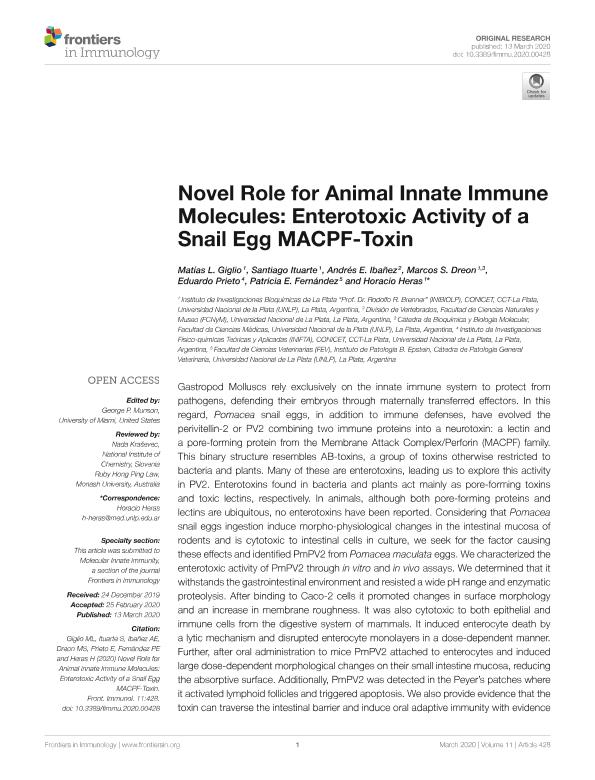Mostrar el registro sencillo del ítem
dc.contributor.author
Giglio, Matías Leonel

dc.contributor.author
Ituarte, Santiago

dc.contributor.author
Ibañez, Esteban Andrés

dc.contributor.author
Dreon, Marcos Sebastian

dc.contributor.author
Prieto, Eduardo Daniel

dc.contributor.author
Fernández, Patricia Ester

dc.contributor.author
Heras, Horacio

dc.date.available
2021-10-14T16:38:51Z
dc.date.issued
2020-03-13
dc.identifier.citation
Giglio, Matías Leonel; Ituarte, Santiago; Ibañez, Esteban Andrés; Dreon, Marcos Sebastian; Prieto, Eduardo Daniel; et al.; Novel role for animal innate immune molecules: Enterotoxic activity of a snail egg MACPF-Toxin; Frontiers Media; Frontiers in Immunology; 11; 13-3-2020; 1-14
dc.identifier.uri
http://hdl.handle.net/11336/143633
dc.description.abstract
Gastropod Molluscs rely exclusively on the innate immune system to protect from pathogens, defending their embryos through maternally transferred effectors. In this regard, Pomacea snail eggs, in addition to immune defenses, have evolved the perivitellin-2 or PV2 combining two immune proteins into a neurotoxin: a lectin and a pore-forming protein from the Membrane Attack Complex/Perforin (MACPF) family. This binary structure resembles AB-toxins, a group of toxins otherwise restricted to bacteria and plants. Many of these are enterotoxins, leading us to explore this activity in PV2. Enterotoxins found in bacteria and plants act mainly as pore-forming toxins and toxic lectins, respectively. In animals, although both pore-forming proteins and lectins are ubiquitous, no enterotoxins have been reported. Considering that Pomacea snail eggs ingestion induce morpho-physiological changes in the intestinal mucosa of rodents and is cytotoxic to intestinal cells in culture, we seek for the factor causing these effects and identified PmPV2 from Pomacea maculata eggs. We characterized the enterotoxic activity of PmPV2 through in vitro and in vivo assays. We determined that it withstands the gastrointestinal environment and resisted a wide pH range and enzymatic proteolysis. After binding to Caco-2 cells it promoted changes in surface morphology and an increase in membrane roughness. It was also cytotoxic to both epithelial and immune cells from the digestive system of mammals. It induced enterocyte death by a lytic mechanism and disrupted enterocyte monolayers in a dose-dependent manner. Further, after oral administration to mice PmPV2 attached to enterocytes and induced large dose-dependent morphological changes on their small intestine mucosa, reducing the absorptive surface. Additionally, PmPV2 was detected in the Peyer's patches where it activated lymphoid follicles and triggered apoptosis. We also provide evidence that the toxin can traverse the intestinal barrier and induce oral adaptive immunity with evidence of circulating antibody response. As a whole, these results indicate that PmPV2 is a true enterotoxin, a role that has never been reported to lectins or perforin in animals. This extends by convergent evolution the presence of plant- and bacteria-like enterotoxins to animals, thus expanding the diversity of functions of MACPF proteins in nature.
dc.format
application/pdf
dc.language.iso
eng
dc.publisher
Frontiers Media

dc.rights
info:eu-repo/semantics/openAccess
dc.rights.uri
https://creativecommons.org/licenses/by/2.5/ar/
dc.subject
AB TOXIN
dc.subject
ANTIPREDATOR DEFENSE
dc.subject
CYTOTOXICITY
dc.subject
INTESTINAL MORPHOLOGY
dc.subject
POMACEA MACULATA
dc.subject
PV2
dc.subject
SNAIL REPRODUCTION
dc.subject.classification
Bioquímica y Biología Molecular

dc.subject.classification
Ciencias Biológicas

dc.subject.classification
CIENCIAS NATURALES Y EXACTAS

dc.title
Novel role for animal innate immune molecules: Enterotoxic activity of a snail egg MACPF-Toxin
dc.type
info:eu-repo/semantics/article
dc.type
info:ar-repo/semantics/artículo
dc.type
info:eu-repo/semantics/publishedVersion
dc.date.updated
2021-09-06T17:28:26Z
dc.identifier.eissn
1664-3224
dc.journal.volume
11
dc.journal.pagination
1-14
dc.journal.pais
Australia

dc.description.fil
Fil: Giglio, Matías Leonel. Consejo Nacional de Investigaciones Científicas y Técnicas. Centro Científico Tecnológico Conicet - La Plata. Instituto de Investigaciones Bioquímicas de La Plata "Prof. Dr. Rodolfo R. Brenner". Universidad Nacional de la Plata. Facultad de Ciencias Médicas. Instituto de Investigaciones Bioquímicas de La Plata "Prof. Dr. Rodolfo R. Brenner"; Argentina
dc.description.fil
Fil: Ituarte, Santiago. Consejo Nacional de Investigaciones Científicas y Técnicas. Centro Científico Tecnológico Conicet - La Plata. Instituto de Investigaciones Bioquímicas de La Plata "Prof. Dr. Rodolfo R. Brenner". Universidad Nacional de la Plata. Facultad de Ciencias Médicas. Instituto de Investigaciones Bioquímicas de La Plata "Prof. Dr. Rodolfo R. Brenner"; Argentina
dc.description.fil
Fil: Ibañez, Esteban Andrés. Universidad Nacional de La Plata. Facultad de Ciencias Naturales y Museo; Argentina
dc.description.fil
Fil: Dreon, Marcos Sebastian. Consejo Nacional de Investigaciones Científicas y Técnicas. Centro Científico Tecnológico Conicet - La Plata. Instituto de Investigaciones Bioquímicas de La Plata "Prof. Dr. Rodolfo R. Brenner". Universidad Nacional de la Plata. Facultad de Ciencias Médicas. Instituto de Investigaciones Bioquímicas de La Plata "Prof. Dr. Rodolfo R. Brenner"; Argentina
dc.description.fil
Fil: Prieto, Eduardo Daniel. Consejo Nacional de Investigaciones Científicas y Técnicas. Centro Científico Tecnológico Conicet - La Plata. Instituto de Investigaciones Fisicoquímicas Teóricas y Aplicadas. Universidad Nacional de La Plata. Facultad de Ciencias Exactas. Instituto de Investigaciones Fisicoquímicas Teóricas y Aplicadas; Argentina
dc.description.fil
Fil: Fernández, Patricia Ester. Universidad Nacional de La Plata. Facultad de Ciencias Veterinarias; Argentina
dc.description.fil
Fil: Heras, Horacio. Consejo Nacional de Investigaciones Científicas y Técnicas. Centro Científico Tecnológico Conicet - La Plata. Instituto de Investigaciones Bioquímicas de La Plata "Prof. Dr. Rodolfo R. Brenner". Universidad Nacional de la Plata. Facultad de Ciencias Médicas. Instituto de Investigaciones Bioquímicas de La Plata "Prof. Dr. Rodolfo R. Brenner"; Argentina
dc.journal.title
Frontiers in Immunology
dc.relation.alternativeid
info:eu-repo/semantics/altIdentifier/url/https://www.frontiersin.org/article/10.3389/fimmu.2020.00428/full
dc.relation.alternativeid
info:eu-repo/semantics/altIdentifier/doi/https://doi.org/10.3389/fimmu.2020.00428
Archivos asociados
